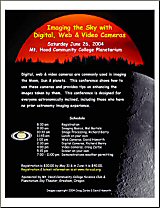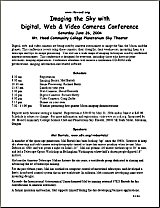<<PREVIOUS -
HOME -
CONTENTS -
NEXT>>
ASTROIMAGING - ITS
![]()
<<PREVIOUS -
HOME -
CONTENTS -
NEXT>>
ASTROIMAGING - ITS
![]()
The Imaging The Sky 2004 Conference was held on Saturday June 26, 2004 at Visual Arts Theater, Mt. Hood Community College (MHCC), 26000 SE Stark Street, Gresham, Oregon, USA. The conference had attendance of over 65 attendees. Mel Bartels, Richard Berry, Dave Cole, Jim Girard, David Haworth and Rick Kang organized the conference. The conference was sponsored by Mt. Hood Community College Science Club, Michael A. Russell and Planetarium Sky Theater, Doug McCarty.

|
Digital, web, and video cameras are being used by amateur astronomers to image the Sun, the Moon and the planets. This conference covered using these cameras, their strengths, their weaknesses, mounting them to a telescope and tips on image processing. Attendees saw a wide range of imaging techniques used by northwest amateur astronomers. Conference attendees received a conference CD-ROM with presentations, imaging information and related software Door prizes were donated by Sean's Astronomy Shop, Pro Photo Supply, Suburban Photo, Starbucks Coffee and the ITS committee. Adirondack Video Astronomy provided customer appreciation certificates. Imaging The Sky 2004 Conference schedule PDF file 14 KB. |

|
What a terrific conference. That was my first time attending this imaging conference. I was very impressed with the organizing of it, the speakers, the amenities. The extra touches were very much appreciated. And winning a door prize to a photography shop was icing on the cake!
Jan
The ITS conference is exactly what I was looking for. I was thoroughly impressed with the speakers' first hand knowledge and their presentations, and I liked all the interaction between speakers and attendees. I called my wife during the first break to tell her how much I was enjoying the conference. All presentations were equally good.
As Jan mentioned, the conference was well organized. The presentations were the right length and the right level. The snacks and door prizes were an unexpected bonus.
Good Job!!!
Don
I can't add a whole lot except to say that it was a *great* conference. I learned a lot and got really excited about trying some of the things taught. And the skies cooperated for our evening demo sessions too. As a bonus, those of us who stayed for the demo sessions got to see the solar telescope at MHCC -- a real treat!
I brought my Canon Digital Rebel SLR and got to try it out on a couple of telescopes aimed at the moon. Plus I saw a great demo session on the Meade LPI camera.
The conference was very professional. I probably shouldn't say this, but the price was a real bargain.
Assuming next year's conference will cover some areas that couldn't be covered this year, I will probably attend.
And one other note: one attendee came all the way from Minnesota and was telling me that evening during the demos how much he enjoyed the conference. He flew out here just for the conference. I know it'd be more work, but there is so much to cover, I bet if it was held over two days and the word got out, more people might come from across the country to attend. We're lucky to have so much astro-imaging talent right here in the Pacific Northwest.
Again, thanks to the organizers and presenters!
--S. Miller
The interest was high for all presentations and there were lots of questions from the attendees of the conference during the below presentations, breaks and evening demonstrations.
Mel Bartels presented differences between electronic imaging and film photography, types of electronic imaging, astronomy imaging basics radiation to sensor to computer file to image, advantages of CCD imaging, disadvantages of CCD imaging, general imaging processing concepts/image quality, and a review of the different types of image processing software that is available.
Richard Berry presented basic concepts, pixels, what can image processing do, calibration, raw image, dark frame, processed image, When calibration is not perfect, stacking multiple images, examples of one image and stacking 60 images, image enhancement, color balancing, stretching, sharpening, cropping, resampling and image processing demonstrations in AIP4WIN and Photoshop.
David Haworth presented astroimaging cameras comparisons, exposure limiting factors, light pollution, poor seeing, average seeing, good seeing, very good seeing, camera exposure times, focal length, exposure vs. focal length, cameras FOV comparisons, ToUcam imaging, ToUcam advantages, ToUcam disadvantages, ToUcam hardware, ToUcam software, ToUcam images of Saturn and Sun, diffraction focusing, solar imaging, Cor Berrevoets RegiStax, Meade Lunar Planetary Imager (LPI), LPI advantages, LPI disadvantages, LPI software, LPI images of Moon and Juipter, and CCD astroimaging information.
Richard Berry presented digital cameras have evolved rapidly, covered basic camera operation, attaching the camera to telescope, afocal optics, focus, exposure, and framing. Examples images of lens not centered, lens too close and lens too far away were shown. Examples of the Moon, Sun, Saturn and comets images were shown. Also, future examples of digital SLR images of deep sky objects were presented.
Craig Zerbe presented astro imaging with video, what is needed, which video cameras work best, what does the raw video look like, progressive scan, imaging to get high resolution results, imaging setup, image scale at the telescope, large image scale means small details, recording the video image, capture to the computer, full frame or semi frame, flat fields, stacked images, deep sky video images, wavelet process, making mosaics, and examples of Moon and deep sky images.
Evening imaging demonstrations by the presenters and attendees started at 8:30 pm and ran until 11:30 pm. First quarter Moon imaging demonstrations included afocal photography with digital cameras, prime focus photography with digital SLR camera and Meade LPI. The Meade LPI was used to image the Moon and Jupiter. Demonstrations were on several different telescopes brought by attendees.
At imaging demonstration the above Moon image was taken by David Haworth with the Meade LPI and Orion Telescopes & Binoculars ShortTube™ achromatic 80mm aperture refractor. Long exposure photos of the evening demonstrations were provide by Richard Berry.